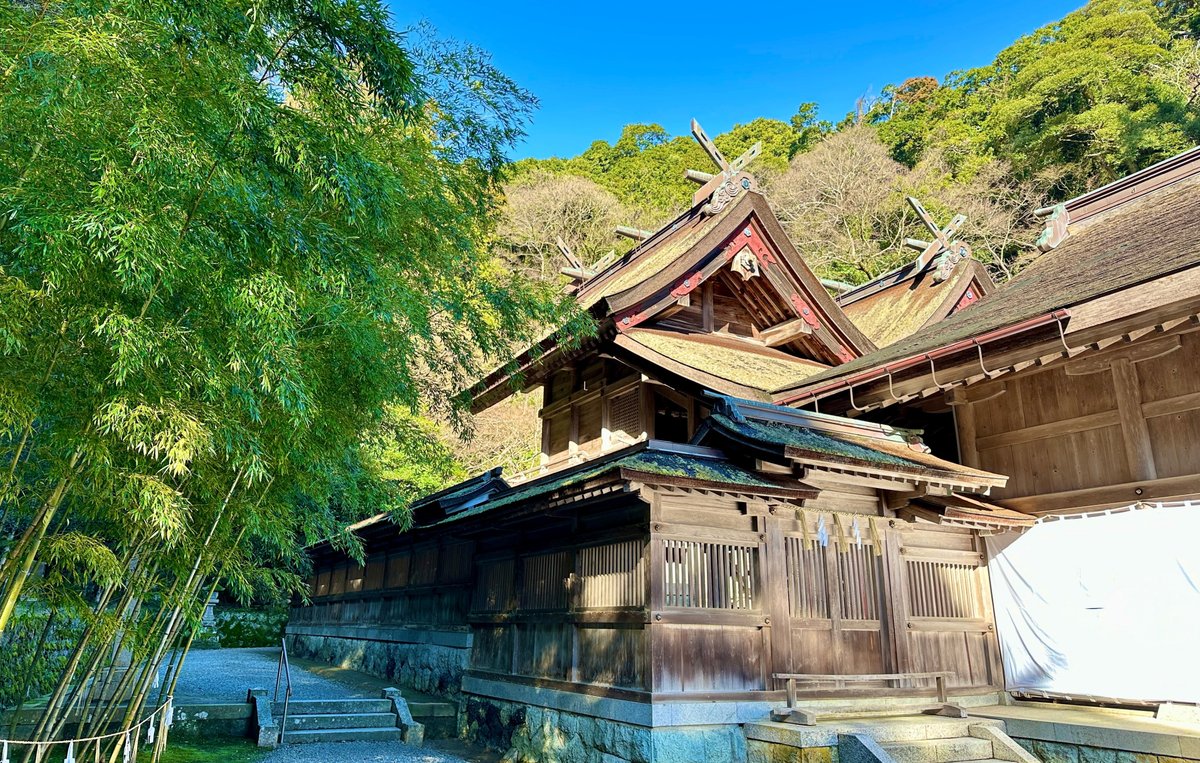
【島根時間.jp】第2回 美保神社 古代から現代へ続く 海と人々を守る祈りの場
美保神社は島根県の穏やかな自然に囲まれた地にあり、歴史と伝統に満ちた神社です。その神聖な境内は、訪れる者に心の安らぎと精神的な潤いを提供する場所となっています。神社の御祭神、三穂津姫命と事代主神は、豊穣、安全、繁栄の象徴として古来から崇敬されてきました。三穂津姫命は稲穂をもたらし、五穀豊穣や子孫繁栄の守護神として深い信仰を集めています。事代主神は、海の安全や大漁を司り、商売繁盛や学業成功をもたらす神として、えびす社の総本宮と位置づけられています。

美保神社の建築はその歴史の深さと神聖さを物語る要素です。本殿は1813年に再建され、国の重要文化財に指定されており、美保造または比翼大社造の独特な建築様式を採用しています。この様式は、二つの神を祀る本殿を「装束の間」で結ぶ珍しい形式で、建築材には地元産の松が主に使用されています。屋根は檜皮で葺かれ、日本の伝統的な建築美を伝えています。


拝殿は昭和3年に建築学者伊東忠太の設計監督のもと檜造りで建てられました。この拝殿は船庫を模した独特な造りが特徴で、壁がなく梁が露出しており、開放感があります。この構造は周囲を山に囲まれた地形と相まって、優れた音響効果を生み出し、神楽や音楽の奉納に最適な環境を提供しています。

美保神社の創建は『出雲国風土記』や『延喜式』にその名が記されていることから、遅くとも8世紀にはその存在が確認できます。境内からは4世紀頃の勾玉の破片や6世紀後半頃の土馬が出土しており、これらの遺物は古墳時代以前からこの地で祭祀が行われていたことを示唆しています。


美保神社と北前船との関わりは特に注目に値します。北前船は江戸時代から明治時代にかけて日本海を舞台に活躍した貿易船で、美保関はその重要な寄港地の一つでした。美保神社は船人たちから深い信仰を集め、海上の安全や大漁、商売繁盛の祈願の場となっていました。美保神社に奉納された846点の楽器はその信仰の証で、中には日本最古のオルゴールやアコーディオン、歴史的な大太鼓など貴重な文化財も含まれています。


私が美保神社を訪れた日は穏やかな風が吹き抜ける清々しい朝でした。この神聖な地を訪れることは、私にとって特別な体験であり、心の奥底に眠る何かを呼び覚ますような感覚でした。境内へ足を踏み入れた瞬間、現代の喧騒から切り離された静けさに包まれました。その静寂の中で時代を超えた祈りの声が空間を満たし、神聖な気配を強く感じました。本殿や拝殿の荘厳な姿は、見る者の心を引き締め、深い敬虔な気持ちを呼び起こします。これらの建造物からは、長い年月を経ても変わらぬ信仰の力と、積み重ねられた歴史が感じ取れます。


特に、事代主神と三穂津姫命の古い物語に触れることで、人間と自然、神々との間の深い繋がりを改めて感じられました。これらの神話は、人々の生活や信仰、自然への敬意が紡いだ生きた教えです。境内をゆっくりと歩きながら、各所に設けられた案内板や奉納された神具を眺めることで、美保神社が多くの人々にとって心の支えであり、希望の象徴であることが理解できました。海上安全や五穀豊穣、家族の和合など、人々の日常に根ざした願いがここに集約されています。美保神社の訪問を通じて、日本の精神性とその背後にある豊かな歴史、文化の深さを新たな視点で捉えることができました。

この場所から受けたインスピレーションは、ただの観光を超えたものであり、私の内面に深く響き、心に残る貴重な体験となりました。訪れた誰もが自らの心に問いかけ、何かを見つけ出せる場所―それが美保神社であり、私にとっては忘れがたい心の旅となりました。この神社が持つ神秘的な美しさと、そこに宿る力は、訪れるすべての人々に平和と癒しをもたらし続けるでしょう。そして私自身も、再びこの地を訪れ、その時々の心境に応じた新たな発見や感動を経験したいと強く願っています。

Miho Shrine, nestled in the serene nature of Shimane Prefecture, is a shrine filled with history and tradition. Its sacred precincts offer a place of tranquility and spiritual nourishment for visitors. The shrine's deities, Mihotsuhime no Mikoto and Ebisu, have been revered since ancient times as symbols of fertility, safety, and prosperity, closely intertwined with the lives of the Japanese people. Mihotsuhime no Mikoto, who brought rice stalks from the heavens, is deeply worshipped as a guardian deity of abundant harvests and prosperity of descendants. On the other hand, Ebisu, governing the safety of the seas and abundant fishing, is considered a deity bringing prosperity in business and success in academics, positioned as the principal deity of Ebisu shrines across the country.

The architecture of Miho Shrine is one of the elements that narrates its historical depth and sanctity. The main hall, rebuilt in 1813, is designated as an important cultural property of the country, adopting a unique architectural style known as Miho-zukuri or Hiyoku-no-Irimoya-zukuri. This style, featuring a rare format of connecting two enshrined deities with a "costume room," primarily uses local pine for construction materials. Its roof, covered with cypress bark, conveys the traditional architectural beauty of Japan to this day.
The worship hall, constructed in 1928 under the supervision of the architectural scholar Chuta Ito, is made of cypress wood. Its distinctive structure, resembling a boathouse, features no walls with exposed beams, creating a sense of openness. This structure, coupled with the surrounding mountainous terrain, produces excellent acoustic effects, making it an ideal environment for dedicating Kagura dances and music.
The foundation of Miho Shrine can be traced back to at least the 8th century, as its name is mentioned in ancient texts like the Izumo Fudoki and Engishiki. Artifacts such as fragments of magatama beads from the 4th century and clay horses from the latter half of the 6th century have been excavated within the shrine grounds, suggesting that some form of worship had been conducted on this site since before the Kofun period.
The relationship between Miho Shrine and the Kitamaebune trading ships is particularly noteworthy. Active from the Edo to the Meiji period, the Kitamaebune were trading ships plying the Sea of Japan, with Mihonoseki serving as one of their important ports of call. Miho Shrine garnered deep faith from sailors, serving as a site for prayers for safety at sea, bountiful catches, and business prosperity. The 846 musical instruments dedicated to the shrine are a testament to this faith, including Japan's oldest music box and accordion, as well as historical taiko drums among its precious cultural properties.
My visit to Miho Shrine was on a refreshing morning with a gentle breeze. Visiting this sacred place felt like a special experience, intuitively more than just a trip, as if awakening something deep within my soul. The moment I stepped into the precincts, I was enveloped by a tranquility as if cut off from the modern world's hustle and bustle. In that silence, I could clearly sense the presence of prayers transcending time, filling the space with a divine aura.
The solemn appearance of the main and worship halls tightened my heart, evoking deep reverence. From these structures, one can feel the enduring power of faith and the accumulated history of prayers. Touching upon the ancient stories of Ebisu and Mihotsuhime no Mikoto, I was reminded of the deep connection between humans, nature, and the gods.
These myths are not mere legends but living teachings woven from people's lives, faith, and respect for nature. Walking slowly through the shrine grounds, observing the information boards and dedicated sacred treasures, I understood that Miho Shrine is not just a shrine but a pillar of support and a symbol of hope for many. It encapsulates the everyday wishes of people, such as safety at sea, abundant harvests, and family harmony. Through my visit, I gained a new perspective on the spirituality of Japan and the depth of its history and culture.
The inspiration received from this place transcends mere tourism, resonating deeply within me and leaving a lasting, precious experience. For anyone visiting, Miho Shrine offers a place for introspection and discovery, making it an unforgettable journey of the heart for me. The mystical beauty and inherent power of this shrine will continue to bring peace and healing to all visitors. I, too, fervently wish to return and experience new discoveries and emotions according to my changing states of mind.
この記事が気に入ったらサポートをしてみませんか?
